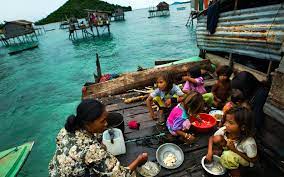

The Bajau people, commonly known as “sea nomads,” live in coastal regions of the Philippines, Malaysia, and Indonesia.
They spend some 60 percent of their working hours in the sea. More than half of their wake time is spent inside the sea.
They are so well adapted to water that in order to forage for food; they dive to the depths of up to 230 feet below the surface: they do this without any specific diving gears or oxygen cylinders.
Bajau divers begin their training very young and these divers are known to hold their breath for several minutes at a time.
They have larger spleens and their body has adapted to their lifestyle, which is why they are so casual even when they dive.
Their genes are modified so that they can lead a better life underwater. It’s like Mother Nature is giving them a helping hand.
They live in a wooden house mounted on wooden poles, which they construct themselves.
And they get to see some of the best views through their windows.
The Bajau people spend most of their lives underwater. Here is how they survive.
1. They pierce their eardrums
Some Bajau people pierce their eardrums to accommodate their free-diving lifestyle to cope with the extreme water pressure underneath. If they do not do this, they will bleed from the ears and nose and end up feeling dizzy: even though this can result in ear loss when they get older.
2. They have long spleens
One difference is that the Bajau people’s spleens are twice as big as the Saluans, their neighbors.
Although spleens are not essential for life, they do contribute to the immune system and function as blood filters by eliminating damaged red blood cells and recycling iron. But most importantly, the spleen stores a quantity of blood.
Mammals’ spleens contract when they are in the water, spreading the blood’s oxygen-rich reserve throughout the body. When swimmers have a larger spleen, it means more oxygen is available.
3. They have longer diaphragms
To survive living underwater, their diaphragms stretch, and the lung wall and abdominal wall also become more flexible.
4. They have a genetic mutation
They also have a mutant gene. The PDE10A gene and the BDKRB2 gene in the Bajau are missing in their closest neighbours, Saluans who do not spend their life at sea.
5. More blood flows to vital organs than their legs
The mutant gene makes peripheral vasoconstriction a diving response. The Bajau’s distinct genetic makeup may help them effectively tighten non-critical regions of their circulatory system.
This essentially means that more blood is transferred to vital organs like the heart, lungs, and brain, allowing for longer dives, while less blood is used in the sections like the legs.
In fact, the story of Bajau people is rooted in their own unique folklore and traditions, with oral history passed down from generation to generation.
They cover their face with Burakor Borak, which is a sun-protecting powder made of water weeds, rice and a variety of spices which is organic. No wonder they do not have any skin problems.
Kinau or Kinalau is one of Bajau tradition food in Borneo Sabah and is called ‘Hivana’ by Bajau people.
It mostly consists of seafood- octopus, fishes, oysters, clams and all the delicacies you can imagine: that too, fresh out of the sea.
They forage for food daily and use some for storage too. Basically, they live the most peaceful and simple life with least possessions.
Their houseboats sail together in flotillas (fleets) with other houseboats, usually of their immediate families or closest relatives.
They come together whether they hunt for fish or to conduct traditional ceremonies.
And they live as one group to support each other as a family, Which is why report says they are the happiest on earth.
Even the kids are expert in sailing and take their own canoes in open waters, all by themselves.
They frequently change their location and make houses while they explore the seas.
Culled / Titilayo Kupoliyi
Subscribe to our Telegram and YouTube Channels also join our Whatsapp Update Group
Abraham chipalo says:
Explanation is not enough for scorpion tail plant, put detailed information.